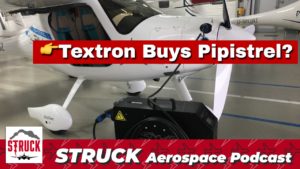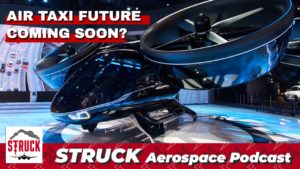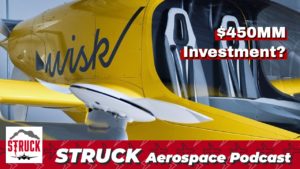In this episode of the Struck Aerospace Engineering podcast, we discuss the Metro Hop ESTOL, news on Volocopter and SpaceX’s plans to “catch” their rockets after flight to re-use them and save money. We also discuss LED panel walls in private jets – could this replace windows? And, Honda’s wing facility – how do they engineer some of the systems in these high-tech manufacturing plants?
Learn more about Weather Guard StrikeTape segmented lightning diverter strips. Follow the show on YouTube, Twitter, Linkedin and visit us on the web. Have a question we can answer on the show? Email us!
Podcast: Play in new window | Download
Transcript: EP44 – Metro Hop Evtol, Volocopter Plus SpaceX Catching Rockets?
This episode is brought to you by weather guard, lightening tech at weather guard, we support design engineers and make lightening protection easy.
You are listening to the struc podcast. I’m Dan Blewett I’m Allen hall. And here on struck, we talk about everything. Aviation, aerospace engineering, and lightening protection.
All right. Welcome back to the struc podcast. On today’s episode first in our new segment, we’re gonna chat about Honda, opening up a new wing facility. Second Virgin orbit. Finally getting up into orbit. It’s exciting. Uh, in our engineering segment, we’re gonna talk about space X, trying to catch the rockets on the way down, which is fascinating and sounds just crazy.
But then again, what is it about space travel? Uh, and then we’re also gonna talk about a wall LEDs and private jets. It’s an interesting new technology report out the, the Robb report. And I’m just wondering if that changes, design, and if that’s going to have any negative drawbacks last year, R E V T O L segment, we’ll talk about Volvo copter, a couple of new designs, um, from manta and also from Metro hop, which is a.
Electric, uh, it’s a short takeoff, um, not necessarily a verdict bill takeoff. So Alan first let’s start with Honda. So they’re opening up a new facility. You’re a big Honda fan. Um, you like their engineering tactics there, you know, they’ve sort of revolutionized painting their aircraft, but this is a wing facility here.
And, uh, what sticks out to you at this, uh, 83,000 square foot facility that they’re bringing to North Carolina?
Well, I think they’ve reached critical mass. When you open another facility to build wings, that means you’re having a pretty good production run. And the part of the facility is also too, uh, handle spare parts.
And I think they have about 170 aircraft in service right now. So you’re starting to get that need of servicing a lot of aircraft in a lot of different places. You need to have spare parts on hand to get them out the door relatively quickly to get the airplanes back in service. So. They needed to have that parts supply center essentially on site.
So they can manage that. Uh, cause most of the aircraft companies, when they get to a certain size will start to do that. So it’s a really good sign. That Honda one thinks there. Production is going to continue at some reasonable rate. And two, it gets some, uh, more room to, to build wings because they had, they were building wings already in the existing factory, but this gives it a lot more space to do it and building a lot more wings concurrently, and then having the parts distributor ship is even better.
So it just looks, even though we’re in the middle of COVID right now, Honda is. Playing the long game has been playing a long game for awhile. And I think it’s a good positive sign for Honda, the Honda jet and North Carolina, because it’s, it’s a big facility, North Carolina, they probably put 200 plus 300 plus million dollars down in North Carolina at this point, plus salaries.
It’s a big
deal. So I have a question and I think this gets overlooked because one of the things that I find the most fascinating about the production of anything is production lines and some of these factories and some of these facilities like this one, I’m looking at these photos of, of Honda. It’s like, Who designed like the first bottling plant, these are tremendous machines.
I mean, they don’t get, you know, they never reached the public eye hardly, but when you see, you know, Coca-Cola being bottled back in the, in the twenties, just flying through the assembly line, these machines are incredibly complex and they’re incredibly precise and they don’t. Break all that often. Right.
Um, you know, so when Honda is making a new facility and we talked about, you know, uh, Bombardi A’s wing facility, do you, is it within their company? Like, does Honda have their own set of engineers? That’s designing the facility, not just the facility, but also just the, the tools in it and the, the processes and the, and the dollies and the things that you’re going to clamp a wing onto and wheel it around.
Like those things are. Incredibly complex as complex as probably a lot of the aircraft parts themselves. How does, how does that
all work? Well, so there’s a separate group. That’ll do that now. I don’t know if Honda has that the engineering group within their facilities that does that. Sometimes it’s it’s outsourced.
I remember when I worked at beach, there was some tooling done inside and some of it done outside depending on what the application was. But it’s a whole, it’s a whole line of business. That’s a whole set of engineering skills that differs from other things, uh, like building an airplane because building airplanes.
So by lightweight keeping the costs down all those little. Little bits and pieces. When you’re designing a factory floor, you’re making things out of steel and you’re making it such that you can keep the, like, like the wing build structure is something that’s very accurately designed because you don’t want to build in a twist or deformation into the wing.
So all those little fixtures that you have to build are really complicated, and sometimes it’s done onsite with the aircraft. Designers or sometimes it’s sent off site, but essentially all those, all the, the, um, mechanical tooling, fixturing, all those bits and bobs to know that it goes from fixture a to fixture B to fixture C as you’re building the wing and constructing it are really highly engineered pieces of equipment that no one really considers and.
One they’re expensive. And two, they’re just a lot of engineering time that goes into those things, right? Because you want to repeatedly use this tool and get accurate results out of it. So it’s a whole industrial engineering, um, approach that gets overlooked a lot of times, but it is probably one of the most important things in terms of the consistency of the product.
Right? If you have bad tooling, you have a bad product just from Santa’s hand. And so, um, the people that do that, uh, Or a special breed because there is a lot that
goes into it. Well, yeah, it would seem really difficult, especially being like an outside group to come in and, and just like say, okay, all right.
You know? Yeah. We specialize in building out these facilities and tools and all this stuff. So tell us what you’re building. That seems like a really long process to figure out, you know, all the components that they’re building and how they build them. And. To then sit down and say, okay, well here’s step one.
It just makes my brain hurt. It’s just a super impressive thing. So, yeah,
you’re right. Cause I think you’re right, because it also depends on how many you intend to shove out the door. How many, how many wings do you tend to shove out the door? That’s changed also. True. That changes the way you design the fixturing.
Right. And how, and is it like in the case of some of the Boeing, uh, Boeing lines where it, it went from a sort of a station approach where aircraft in station one that moves to station two and station three, two. The aircraft solid moot, always moving approach, which is similar to what would happen in Detroit.
When they’re making automobiles where the assemble line is always moving constantly. And you’re putting the parts on as the, as the cars, we went down the line, they were doing that. Or would they have done that at Boeing where the production line is continuously moving and you you’re putting. Parts on the aircraft, as of moving down the line, how does that going to do that?
Cause the quantities aren’t that high. I don’t think so. It’s going to be more of a station approach, but it does change the way you design all that tooling and fixturing is, is based on how much you’re going to ship out the door. And I know at times when they’ve had. Large increases in production at some of these aircraft companies.
What do you do? You, you’re sort of built into this, uh, mindset or system of typically stationed builds. And if you have to double that production, essentially what you need to do is build another facility and build the same set set up. You already have to increase production. You can’t jam or into the system without completely redesigning the system and spending a lot of money to redesign it.
So you kind of have one shot at it. You kind of know. Maximums and minimums are going to be, and you design the tooling around that maximum. Yeah.
That’s uh, just like I said, it’s like a whole other thing beyond just the complexity of the plane or the automobile or the Coca-Cola bottle itself. So it’s just mind blowing stuff.
So let’s talk about Virgin. Uh, so Virgin orbit. It’s launch or one rocket has finally made it into space. So, Alan, this is a big day, obviously space X has done this. Um, where do you see Virgin orbit fitting into this sort of, uh, you know, the big players, obviously, they’re one of the bigger players with blue, blue, blue origin and SpaceX.
Um, but this is exciting for them. How do you feel about it? Well, it it’s
similar to technology that, uh, orbital sciences was doing probably mid two thousands, uh, where they had, uh, I think it was an MD 11. They were dropping, uh, payloads off on these rockets are amounted to the bottom of an, uh, I think it was an MD 11, Mimi and DC 10 or, uh, L 10, 11.
But, um, essentially the, the thought, the thought process of the Virgin setup is it’s on a seven 47 platform, but you’re basically taking the you’re, you’re pulling up the smallest rocket on the bottom of the seven 47. You take it through mostly atmosphere, which reduces the amount of fuel burn you need on the rocket.
So it can make them rocket smaller and you drop this rocket off the aircraft, and then it. Shoots itself up into space and for smaller payloads, that makes a lot of sense because it’s a lower cost alternative, uh, to a disposable rocket. If you think of it that way, if you, if you start with the concept of all rockets are disposable on one-shot events, like it used to be.
Five years ago, uh, uh, putting it on an aircraft reduces the overall cost of launch, particularly things are not going that high up in orbit. So, uh, the Virgin effort was sort of an outgrowth of what an already previously occurred, but maybe in a more efficient manner. The problem right now is the cost that cost versus the space X costs.
You gotta wonder if the space X approach of reusable rockets. Is going to oversee, overcome the Virgin effort because has got two things going on in parallel, right? The end of the Virgin orbit in the Virgin galactic and the galactic is the human launch, right? That’s the shuffle into the space. Look outside the window, uh, efforts going down in New Mexico.
Then you’ve got the orbit, which is more by satellite launches. So Virgin has got two things going on. Parallel. Uh, I wonder if they’re in a pinch right now. I wonder if Virgin’s in a pinch because of how fast space X has gone on and launch people into orbit to the space station and how, how quickly they are able to launch small spacecraft into orbit, also the space X and on a reusable platform.
So the, the cost of going down to the insurance costs have gone down for space X because they’ve demonstrated that they can reuse the rocket and they just don’t lose a lot of those spacecrafts. So, um, Wonderful is kind of an, a pinch here, even though that’s just a great success. I can’t wait till Virgin galactic gets going.
Um, No technology wise, you kind of wonder if Virgin’s going to be in trouble here.
Our, our, uh, engineering segment today. First thing we’re going to talk about is a interesting article out of Rob report.com. Uh, this eco-friendly business jet is using essentially floor to ceiling, not quite floor to ceiling, but. Panoramic wall, all led screens to project, uh, essentially the environment.
So if you’re flying in this private jet, which is extremely nice, um, you know, you could be looking out into what appears to be the horizon appears to be a forest. It appears to be whatever, I guess you want it to be, um, And this is an interesting concept because we talked about some planes in the past.
Like the Solera 500 L was one of them where they had really small windows because of their aerodynamic design. And obviously passengers want to be able to we’ll look out the window and you can feel pretty claustrophobic being in a small tube, especially with private jets, being business jets, being, you know, lower, um, you know, floor to ceiling Heights.
So. Alan, is this something that’s going to catch on? I mean, would we ever see this, do you think, in a commercial airliner in the future,
I don’t know. You know, Boeing did a number of, of, uh, experiments on, on aircraft lighting. And in fact, they’ve incorporated some of those into their newer aircraft where they can change
the yeah.
That’s sky that li that like sky blue light to leaks in. Like, I like that. Yeah. And
they know there’s some calming effect to the color of light, right. That, uh, Doesn’t blue light help keep you awake as not one of the things are, keep
your test shot of, yeah, I don’t know. There’s a lot of misconceptions about blue light.
Those blue light glasses are essentially like snake oil from what I’ve heard. Um, listened to actual optometrists people that actually know the eyes. Um, but anyway, I digress, but yeah, the blue is great. Yeah. So
there’s, there’s, there’s a lot of, uh, Uh, things you can do with lighting now most because the LEDs and you can change color with LEDs and it’s, it’s cool technology.
So there’s been a lot of things in the, and even aircraft are flying today, which they can change the colors in the cockpit and the cabin and do all these wonderful, neat things. The, the need for passenger windows has always been one of those pinch points because it’s a. It changes the way the structure is and adds weight to the aircraft.
But windows in a, that’s not so much a drag thing as it is just extra weight, because anywhere you put an opening in a pressurized tube, you’re going to have to reinforce that opening. And therefore there’s additional weight that goes along with that. Plus the windows themselves are not necessarily structural, but they need to be inspected.
And there’s. I think there’s two, there’s usually two layers. There’s an outer one. And then an inner inner. So you’re not, you’re not actually, if you’re sitting on a seven 37, you’re tapping on the little plastic window, you’re not actually tapping. You’re not actually tapping into the outside world as a little plastic window there.
And then there’s one on the outside, which is actually in the airflow. So there’s like two pieces there that always have to be maintained. And when aircraft are converted to freighters, the first thing to do is a rip out all those windows and put in aluminum plugs. So they don’t have to deal with the windows and inspecting the windows and the, and the weight of the windows.
So the windows are only there for passenger purposes to look outside and make everybody calm. Uh, but if you had some, a system. That would project an outside image. That would be pretty cool. And the way that this little article talks about projecting, basically any image as be like, uh, uh, what’s the big there, what’s the big movie theaters IMAX.
It’d be like an, a BB and I like being in an IMAX almost. And, and I always think, well, that’s cool. I mean, I would like that, but people get motion sick. Don’t like that because yeah. What your eyes see and what your inner ear. Are detecting, uh, if they’re, if they’re getting two different signals, like I’m stationary, but my inner ear is saying that I’m moving.
That’s where seasickness comes very quickly. So, yeah, it was pretty cool. I mean, I guess you could watch movies. I mean, it could display movies on the side of the airplane. Um, but what I, you know, if it’s an effort to get way, get rid of the windows, I think there’s a positive for that. If it makes everybody sick or motion sick, and it was probably negative aspects.
So they’re going to have to weigh that out. And I also think one of the things about putting any sort of electronic technology within reach of passengers is that it’s going to get damaged. And really the business jet market is less susceptible to that. Uh, but on a, a three 20. There’s just too many fingers to me, a little kids banging on stuff that it would probably break it, which would defeat the whole purpose of it.
So there’s, it’s got some neat technology. I do think we’re going to see the elimination of windows coming up pretty soon in the next 15, 20 years. And I’m going to think you’re going to see screens and cameras there to simulate the outside world or to take images of it and display it instead of having the windows, I think that’ll happen, but it’s going to take time for.
People to adjust to
that. Yeah. Agreed. So let’s go back to space X. So they’re trying to launch, or they’re trying to tower catch. Um, there. Heavy rockets. Um, so Alan, what does this actually mean? Because I think for people who aren’t familiar with with this idea of catching a rocket, it’s, it’s a little bit foreign to us.
Yeah. It’s pretty
much foreign to everybody at this point, because we’ve seen the, uh, the Falcon nine design where the there’s legs. Sort of built into the side of the rocket and as the rocket gets close to its landing site, those legs pop out and provide a platform to stabilize the rocket and then it lands.
But you’re carrying the negative side of that is that you’re carrying this weight in which you use for a fraction of the flight just to last. 30 seconds. Do you need those, those landing gear? So if you can eliminate the landing gear, you could add more payload or use less fuel one of the other, uh, to get the rocket into orbit.
So if you could catch the rocket via. Like on the, uh, some of the newer stuff it’s basics spacecraft. If people are watching some of those things, it’s got those, those fins, this fence near the top, uh, if you could catch the S the rocket with those fins, then. You wouldn’t need a landing gear. It, it does make sense, but it really increases the, the, uh, accuracy and the control system so that you have to bring that rocket within a really tight, narrow window to get that system to work right now with the little feet mechanism, I’d say they’re probably plus or minus 50 feet from dead center.
Uh, when they land, when they land the Falcon nine it’s like that. And if you have some sort of, it’s going to grab onto it, it’s gotta be within feet. Like a couple of feet. You’d have to think. So your accuracy of, of your guidance systems has to go way up and maybe they already have that technology. And they figured out they can do it, but there’s, it would take a little bit of time, but I understand that the need and the desire to reduce unnecessary weight.
And there is a complexity to that landing gear feed system. Even though it has been pretty reliable. I haven’t seen the Danny. Have you seen the F the landing gear system fail? No. No. I haven’t seen one of those gear collapse yet. A scene where they missed and rock, I guess it’s the rockstar had tipped over some of the early ones, but, um, lately, no.
So you gotta wonder if it’s just. A ULA Musk. Hey, this is a way to save a thousand pounds on this rocket to get rid of this, all this, all this feat. Let’s try it. Got nothing to lose. Let’s see what happens and if they can get it to work, they get it to work. If not, not in the back too. The system, they know it works, which is the feet.
All right. Moving on to R E V T O L segment today. First, we’re going to chat a little bit about vole copter. So they’ve, they’re making a move towards us. Uh, urban air mobility. Um, so Alan, it says that their application was accepted by the FAA on the 22nd of December. And, uh, to concurrently validate the ASA type certification that they hope to get in the next two to three years.
So what does this step move your, our certification guru? What does this, what does this mean for, uh, for you have to go to
down two steps, two separate pathways, but essentially the ASA has one set of rules and the FAA has another set of rules. They’re trying to. Normalize or standardize those rules between the two.
I think that’s where they’re going is to say, IASA wants this role and the FAA wants that role. Well, how do we satisfy both as inexpensive and simplistically as we can. And so then now that they’re addressing it upfront, I think it’s, it’s a smarter way to go about it. The FAA is not adding additional rules and I’m not writing new rules based on these, these smaller, um, uniquely designed aircraft.
What they’re doing is they’re taking the existing rules and applying them particular to that installation or that design. Very similar to what the FAA had done years ago for the bell six Oh nine, which is now Augusta Westland, which is now Leonardo 609 tilt rotor design, which was at the time a very, uh, unique aircraft.
And that had rotated the, the head. Propellers at the end of the wing, that the tilted up and down, and it’s very so much of the , but the F the FAA hadn’t certified the V 22, the military had. So, uh, the FAA went through this process of basically picking and choosing regulations to apply to that specific design.
So they pick them out a different, uh, regulatory buckets. So they use a smaller aircraft or some the small rotocraft or some other regulations, and they kind of combined them into this. Big list of here’s your compliance checklist. You have to demonstrate compliance with the helicopters, doing the same thing.
They’re trying to create that compliance checklist, just to the list of things that we have to go do, and then figure out where the differences lie, identify those differences and try to do dress some earlier rather than later. And I think that makes a lot of sense because the vole copters or design is pretty far down the road pathway.
I haven’t seen any significant changes to their base. Aircraft design it’s looks like it’s pretty well stabilized. And all they want to do now is show that it’s airworthy, which is a good place to be. If you feel like you’ve got a relatively robust system and your systems engineers have demonstrated. If I lose a particular electric motor, it doesn’t matter.
Uh, if I have, uh, You know, some sort of computer upset, I can still fly the aircraft to where it needs to go. All those little safety things that are probably have been done by them. So at this point, it’s really just going down and demonstrating that the, that the aircraft will meet the FAA. And he also regulations, which is a good place to be.
That’s probably a two to three-year process typically, um, and probably a 200 to $300 million event, but it’s, it’s doable. And I think Volvo copper has got a pretty good shot. Compared to some other designs we have seen recently. Yeah.
So speaking of other designs, so, uh, we’ve got a new one here. Uh, manta just Swiss company has two potential designs.
The a and N one was a single seat and the a N N two, a double seat. And they’re actually, they can vertically take off and also do a short. Runaway takeoff for sure is a hundred yards. Of course, these are just renderings. They do not exist yet. Um, but these look like they look like fighter jets and they’re buried by four ducted electric fans and they potentially can get to 186 mile per hour, a cruising speed with a range of nearly 400 miles.
Um, Allen. How do you feel, how do you feel about this design?
Like it’s going anywhere based on where the other Evie talk designs are at today. If you take a look at the Joby, the heavy side, the fuller copter, all those designs do not use ducted. Fans. And I think there’s a reason for that because there’s those transition issues.
As you go from vertical flight to horizontal flight there’s, if you’re rotating these ducted fans or have something that, um, you have these weird aerodynamic effects that happen as you’re moving forward, where you’re not producing the thrust, you think you’re going to be producing. And then the ducted part goes away.
So, and surprising. There’s a lot of ducted fans still around because even NASA is not doing that. I mean, everybody has seen to make the jump to basically it’s a. Propeller moving air, nothing else around it. It’s a simple design. The only one that’s still kind of in that mode is really Lilium, but they’re using a lot smaller, a lot smaller fans.
I’ll call them. I guess they’re kind of ducted fans in a sense, but there’s 35 or 36 of these little, little motors. So it’s weird to see a design that looks like it’s five years old. Honestly, um, you think you’d take a look around and see what everybody else is doing. That’s in flight test because the flight test will the flight test doesn’t lie, essentially.
Uh, you see, you see changes in design only because flight tests forces you that way. Even, even beta, which is up in New York right now doing flight tests, doesn’t use any ducted fans. So anytime I see a new ducted fan design pop out, I think, wow, that’s just. So old it’s so 1990. That’s what it seems like, right?
It’s like, ah, no, no, no, no. There’s something fundamentally
wrong with it. Yeah. Your, your thing has always been the complexity. Like the more complex it looks and the more off the beaten path it looks, I mean, the percentage, this is just not going to work financially or otherwise it just skyrockets. I mean, that’s been your thing is like stop deviating so far from.
A what’s come before and now what the front runners are doing. And I think that’s one of your central points that makes a lot of sense. Like, this looks nothing like any of the front runners. Right. And it looks a lot like a fighter jet and it has ducted fans, which no one uses. It’s like all that stuff should add up, but it doesn’t seem to for some companies, no,
I think the PR overtakes the reality sometimes that it does play like a lot of aircraft program is over.
My lifetime where there’d be a big splash, a PR some really cool renderings of what this aircraft in theory is going to look like. And they shop at to see if they can get funding. And when they get funding, they said to get started going down that process of trying to build a thing if they don’t get funding.
So what, they just spent some money on some renderings. That’s what it feels like. So unless there’s, they could attract a huge investor when I’m a huge investor, I’m talking about a hundred plus million dollars investor, then it will never come to fruition. And these types of things, because the only way these small aircraft are going to make the money they need to stay afloat is they got to sell.
Literally thousands of these and then probably be also participating in the, in the marketplace. Like Uber does like every flight. You’re going to take a percentage of, if you’re not doing that and it’s. Pointless really is pointless.
So our last design, we have another new design to talk about today is from Metro hop.
And this one’s interesting because they’re not a vertical takeoff landing. They’re a short takeoff and landing, so they believe they can. Um, besides. Covering 125 mile radius at a 250 mile per hour. Cruising speed. This little aircraft, um, only needs 82 feet. So what they’re saying of runway, which could make rooftop, runways a thing, Alan, how do you feel about rooftop runways?
They’re
an awful idea and they’re just an awful, awful idea because it’s just too much risk with the Villa. Very little reward. The risk. Is that on a rooftop? If you were going to take off and had some sort of problem. What’s the likely outcome. Well, you’re going to run into something or somebody and do a lot of damage on the ground.
The reason the airports are not necessarily near big. Uh, industrialized centers is because of the consequences of the aircraft and it making it off the runway properly. Um, and that’s why a lot of the vast majority of airports are not located in highly populated areas. So putting an aircraft, takeoff and landing inside a highly populated area, it doesn’t even make any sense.
Why do it. Um, yeah, but a short takeoff, a short takeoff on a, uh, on a smaller strip in a, in a, in a rural environment, it does make a lot of sense in that. Um, it opens up a lot of the plate, a lot of smaller pieces of property. You could have a takeoff, a landing spot, like if I’m in. Kansas. Let’s just pick Kansas because I like Kansas.
So if you’re in Kansas, there’s, there’s a, there’s already a lot of runways out there. You’d be surprised how many runways are, I think around Wichita there’s like six or eight different runways you can get in and out of. Um, but yeah, I mean, it does make it personal on some sense, um, because you, you wouldn’t need to put down that much asphalt, which is the benefit too.
And there is some benefit, um, I do think there’s a benefit to having a shorter takeoff and shorter landing and a lot of places like up in Alaska, it’s a benefit to have that because the takeoff and landing spots are relatively short or they’re between two mountains. So you need to have a short takeoff in short landing, short landing aircraft, which would make a lot of sense.
But I just, Dan, I, I’m not going to fly to my local pizza shop and land on top of the pizza. You know, that doesn’t make any sense to me and even the Tahoe thing. So let’s just talk about Lake Tahoe. So Lake Tahoe is a very, um, exclusive place nowadays for a lot of the Silicon Valley, uh glitterati to travel, to and have homes up around Lake Tahoe and Lake Tahoe is beautiful by the way.
Uh, but there’s an airport right next to it. So why couldn’t you to the airport and take the five minute drive from the airport to your multimillion dollar home. It’s at Lake Tahoe. Why do you have to land at your home? I guess that doesn’t make any sense to me. The downside risk is so enormous that. The short takeoff things are cool.
I gotta admit, uh, sorta this, this aircraft has like a leaping feature where it wants to basically bounce up in the air. Oh, that’s pretty cool. If it shortens the takeoff time and I could put it on a smaller piece of property. Awesome. But I just don’t think flying towards a populated area. It makes any sense.
None. Well, yeah. I mean, you skid off the runway or one time, and then you crashed down to the street below and. Yeah, I mean, terrible, terrible consequences. Well, one thing that they do mention in this article, uh, is that the company plans to first, you know, potentially do piloted cargo, uh, versions of the plane and, uh, could potentially transport goods from hospitals and stuff like that.
So it seems like. Someone there has got an idea that, Hey, this is probably not like, you know, but you know, landing on rooftop city mode first, like, let’s see how we can utilize this short runway model and, you know, get vaccines or, you know, get organs and, you know, get maybe potentially even people I don’t know about that, but just, you know, cargo from.
You know, in places where it’s like, Hey, can you get this over here in 20 minutes? Like, we really need this, this liver for a, for a patient that makes a lot of sense. And, uh, that’s kind of been like, my thing is like, we should, a lot of these things should be tested probably commercially first, you know, just take your EBTL from the shore to the cargo rig and back bring, you know, prove the model.
That way first and then figure out the viability and then see we’ll maybe we can apply as to consumer. And it seems like they’re, they’re thinking about that, which I think is good.
I do think the cargo approach has a lot of benefits to it, to one figure out the technologies who were, can be used. And two there’s just less risk in it, on the, on the company side, because you don’t use not full of people.
Um, and, and that’s where the Alaska thing I think is interesting. And because. If you ever watch shows of that. And there’s actually companies that deliver to remote parts of Alaska and those runways are icy or they’re short or they’re between mountains and all that kind of fun stuff. If you could open up access to a lot of different places where there is civilization and they people need.
Short takeoff and landing aircraft and it, and it’s a yeah. Trick and it’s available. And it’s just a faster means of transport, less expensive means of transport, which it will be. Then there’s a huge opportunity there that seems to get overlooked because everybody’s still thinking they’re going to go from their apartment roof to some restaurant roof.
That’s just not going to happen.
All right. Well, that’ll do it for today’s episode of struck. If you’re new to the show. Thank you so much for listening. And please leave a review and subscribe on iTunes, Spotify, or wherever you listen to podcasts. Check out the weather guard, lightening tech YouTube channel for video episodes, full interviews and short clips from the show and follow us on LinkedIn, Twitter, Instagram, and Facebook.
Our handle is at WG lightning. Tune in next Tuesday for another great episode on aviation, aerospace engineering and lightning protection
tape weather guard, lightening text proprietary lightning protection for radomes provides unmatched durability for years to come. If you need help with your radon lightning protection, reach out to us at weather guard. eero.com. That’s weather guard, H E R o.com.












